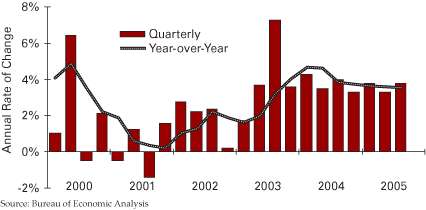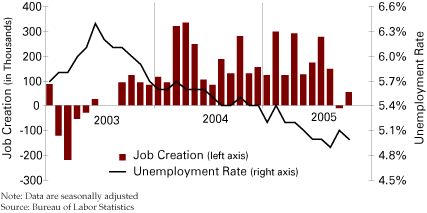The U.S. Economy
Indiana University, Bloomington
Prior to the left-right combination of Katrina and Rita (Katrita for short), the economy was headed toward a very satisfactory 2005. Growth in the first half of the year was at 3.6 percent and seemed to be accelerating. This extended the solid recovery that began in earnest during 2003 (see Figure 1). Employment growth was averaging over 190,000 per month, implying about 2.3 million new jobs for the year. Unemployment in August was below 5 percent, down one-half percent from the end of 2004 (see Figure 2). Inflation (measured by core consumer prices—that is, excluding the volatile food and energy sectors) was stable at about 2 percent. It was reasonable to expect that 2006 would bring a continuation of these trends.
Figure 1
U.S. Real Output

Figure 2
U.S. Job Creation and Unemployment

Of course, even in ordinary circumstances, forecasting the economy is something of a fool’s errand for several reasons: First, much of what happens (especially for short-term horizons) results from inherently nonforecastable events. Second, economic data include a lot of noise and arrive after the fact. Third, our conceptual understanding of the forces that drive an economy as complex as the United States, while arguably improving, is very far from perfect.
The current situation is a textbook example of these difficulties. Five months ago, Katrita was in no one’s forecast. Looking ahead now, there is very little concrete basis for predicting a wide range of important variables in the aftermath of the storms: How long will energy prices remain high? How much government aid will flow into the region (and how quickly)? How much will transportation infrastructure damage disrupt economic activity outside the region?
The storms will also seriously distort virtually all economic data for at least the next few months. To a considerable extent, the numbers will be the result of guesses made by government statisticians as to how to incorporate the storms’ effects. But even if we could confidently predict answers to questions like those in the previous paragraph, and even if we had reasonably good data, sorting out the quantitative effects of all the opposing forces in the current situation goes beyond the capability of available economic models.
So be forewarned—what follows comes with a higher degree of uncertainty than usual.
That said, we expect 2006 to be a reasonably good year for the national economy. We think the economy will continue to expand, probably close to its performance during the past year. Employment will also continue to rise, but a little short of 2005. Some details:
- We expect output to grow about 3.6 percent in 2006, similar to 2005 and somewhat above the long-run potential of the economy.
- Employment will expand by about two million. This will be enough to bring unemployment back down to its levels just prior to Katrita, but not much more.
- Inflation overall will be similar to 2005, possibly somewhat lower with energy prices stable rather than rising. The consumer price index will increase about 3 percent.
- The Federal Reserve will push short-term interest rates to at least 4.5 percent—a level we expect to be reached early in the year.
Basically, our outlook is that the direct damage to the economy from the storms, as well as the indirect damage due to elevated energy prices, will be mostly offset by the stimulative effects arising from the rebuilding effort.
Sources of Uncertainty
Our relatively sanguine outlook could be knocked off course by potential shocks coming from many directions. At least three of these merit more extensive comment: energy prices, the housing sector, and the level of national saving.
Our outlook assumes that energy prices will remain high, but will not escalate further from the levels reached post-Katrita (that is, crude oil prices around $65 per barrel, gasoline a little under $3 per gallon, and natural gas about $13 per million Btu). These levels will clearly put pressure on the economy, especially on energy intensive sectors (airlines, for example). But we think such pressure will prove bearable. However, if energy prices were to rise beyond our assumed levels, the resilience of the economy would be severely tested. Moreover, given the current tightness in the supply situation (particularly for natural gas and refined products), it would not take much to drive prices higher.
Another danger related to the rise in energy prices is that inflation and inflation expectations could move higher. If this were to happen, the Federal Reserve would probably react by pushing interest rates higher than our forecasted levels.
Rising interest rates are particularly significant for the housing sector. The rate increases we expect—roughly another 1 percent across the yield curve—will raise mortgage rates to about 7 percent. Given rebuilding in Louisiana and Mississippi, this is probably not enough to prevent another good year for the sector. However, if rates were to go higher than our forecast, new construction could slow significantly. For some homeowners (particularly those with adjustable rate mortgages) a combination of higher rates, significantly higher bills for heating, and perhaps higher insurance costs could create a serious budget bind.
A third cloud hanging over the economy is the low and decreasing level of national saving. In another dimension of the consumer budget dilemma, personal saving has fallen to virtually zero over the past two years. The net worth of the household sector has been insulated from this lack of new saving by increases in the value of existing assets (equity values during 2004 and housing values for several years). Looking ahead, we do not expect these gains to continue at their recent levels. The second component of national saving (from the government sector) has also deteriorated. Since the beginning of 2000, the combined budget of federal, state, and local governments has swung from a one-quarter trillion dollar surplus to a one-quarter trillion dollar deficit. The only piece of the saving puzzle that has been favorable recently is that of the corporate sector. But even with this factored in, the picture is not good. The total level of national saving is now only about one-third its level during the late 1990s. Over the past four years, total national saving has been less than 20 percent of its amount during the previous four years.
This saving shortfall is made up by borrowing from abroad, which necessitates a large and growing international trade deficit. The resulting accumulation of foreign-held U.S. debt could easily put downward pressure on the value of the dollar in the foreign exchange market.
The above litany of problems is especially ominous in two regards. First, the problems are interrelated. For example, higher energy prices carry a risk of inflation, as does depreciation of the dollar. Inflation, especially if it leads to higher interest rates, could further squeeze household and government budgets. Second, all of them involve pressure on the household sector. If this pressure were to cause any significant pullback in consumer spending (which comprises two-thirds of the total economy), the economic outlook would worsen dramatically.
We think, however, that the more likely outcome is that both households and the economy as a whole will muddle through. The year 2006 will be a reasonably good year with adequate growth in output, continued improvement in the labor market, and only slightly elevated inflation.
Also in this Issue…



